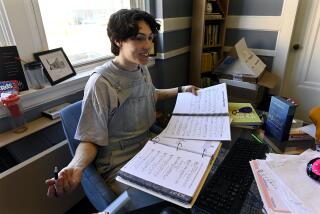‘Downsized’ Students Learn About Reduced Expectations
- Share via
FAIRMONT, W. Va. — Aida Everhart’s students are in their seats before she starts the day’s lesson, their textbooks, “How to Get the Job You Really Want,” open to page 17. On the wall, posters of Albert Einstein, Beethoven, Monet and John Wayne stare down at them.
In an upstairs room another class is at a bank of computers, learning word processing. “The resume,” Everhart is telling her students, all former miners, “is the first step in selling yourself.” There are 30 people in her class, mostly men in their 40s. One is illiterate. Another has a master’s degree. “When I went to work 25 years ago,” whispers one student, “there was no such thing as a resume.”
For the next six months, the 100 or so students at the White School will spend four days a week brushing up on forgotten skills. They will subtract fractions, run through vocabulary lists, write resumes, hear speakers talk about the job market--and know that no matter how good their fortune, they never again will find a blue-collar job in Marion County that pays an average of $51,132 a year.
Although coal production is at record levels, here in Appalachia--the region that fueled the Industrial Revolution and America’s muscle through two world wars--mines are closing with distressing regularity. Suddenly miners who thought there would always be work for a man willing to disappear into the bowels of the Earth each day are asking: What do I do now? For Americans wondering how “downsizing” can affect a working person’s prospects and spirit, Fairmont is something of a microcosm.
“I used to be fairly good in math, and now, doing this stuff, you realize how dumb you are,” said Ray Satterfield, 42, who, like his classmates, has little chance of returning to the depressed coal fields.
“My biggest fear,” said Roman Prezioso, administrator of the adult education center, “is that there won’t be jobs out there for these people. You put an individual through the skill-training program and he’s ready to rejoin the work force. If he can’t find a job, that’s a double-whammy.”
According to a recent state survey, West Virginia has 349 job vacancies. Only one is in mining and only seven offer salaries of $25,000 or better a year. The vast majority, 194, pay $6 or less an hour. Some samples: ticket agent, hotel clerk, telephone solicitor, short-order cook, typist.
“We’re not typewriter people,” said Gary Eagle, 42, one of Everhart’s students. “We’re labor-force people, blue collar. I may not be able to compete with the 4.0 college guy who can type 120 words a minute, but I can tell you this: I’m not afraid to get dirty, and I got a good work ethic.”
Largely because of automation, the nation’s labor force of coal miners has fallen from 700,000 in the 1920s to just over 100,000 today, only about two-thirds of whom are union members. Since 1991, more than 1,000 mines have closed in the United States, almost all east of the Mississippi, where the Clean Air Act of 1990 has sounded a death knell for producers of high-sulfur coal, like the mines around Fairmont, 87 miles south of Pittsburgh.
*
The act forced coal-fired power plants, which account for 56% of the electricity produced in the United States, to cut emissions of sulfur dioxide (the cause of acid rain) in half by 1995 and make further reductions by 2000.
For the jobless victims of the Clean Air Act, Congress has provided a safety net when unemployment benefits run out in six months: Free schooling for up to two years to learn a new skill, with continuing benefits, about $290 a week.
Thirty-three have enrolled in Fairmont State College. “We’ve got miners here who were making $75,000 to $80,000,” said Fairmont’s admissions counselor Charles Endicott, 41, himself a miner for 17 years. “They’re not going to make that even with a degree, but they’re preparing for new careers in computer information processing, health care, as chefs, small-business owners and electricians. And, on the whole, they’re very upbeat, very determined.”
Times researcher Edith Stanley in Atlanta contributed to this story.
More to Read
Sign up for Essential California
The most important California stories and recommendations in your inbox every morning.
You may occasionally receive promotional content from the Los Angeles Times.













